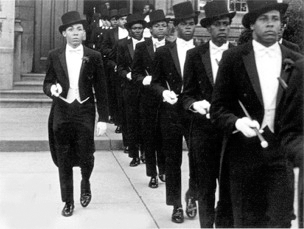 The use of walking sticks and canes may very well date back to centuries B.C. to the times when shepherds would tend to their flocks. This ties into the early roots of Christianity and leads to the candy canes of today being striped the way they are (3 thin stripes and 1 solid stripe) to remind us of the Father, Son, and Holy Ghost and the blood of Christ. The shape was believed to be chosen because the cane, if pointed upward, resembles the letter “J” for Jesus. The history of the cane also ties in with the African Rights of Passage, and was a symbol of manhood that had to be carried by initiates wishing to become adult members of their respective tribe.
The use of walking sticks and canes may very well date back to centuries B.C. to the times when shepherds would tend to their flocks. This ties into the early roots of Christianity and leads to the candy canes of today being striped the way they are (3 thin stripes and 1 solid stripe) to remind us of the Father, Son, and Holy Ghost and the blood of Christ. The shape was believed to be chosen because the cane, if pointed upward, resembles the letter “J” for Jesus. The history of the cane also ties in with the African Rights of Passage, and was a symbol of manhood that had to be carried by initiates wishing to become adult members of their respective tribe.
Dealing more directly with the evolution of the cane and how it relates to the Fraternity, canes started off as assistive devices, and later turned into social status symbols for society. In the 1700′s and 1800′s, canes were a fashion embellishment. One “wore” a cane. These old canes were decorative, objects to be admired and be proud of. They became collector’s items and represented the true sign of a Gentleman.
Members of Kappa Alpha Psi Fraternity have always worn or carried canes since the beginning of the Fraternity in 1911. Although unintentional in its inception, this occurrence soon became an unofficial tradition of Kappa men, as Kappa’s have always striven to be noble and productive members of the community. Members of the Fraternity then proudly adorned the cane, being the symbol of a Gentleman who exhibits such characteristics.
This type of display became commonplace up until the 1950′s when Black Greek Letter Organizations, on an undergraduate level, began to practice what is known today as “Step Shows”. Undergraduate members of Kappa Alpha Psi Fraternity took part in the trade and soon incorporated the use of their favorite item, the cane, into the routine. This was something that spread to many undergraduate chapters during the 50′s and 60′s. Stepping was catching on at an accelerated rate among the African American fraternities and sororities during this time period.
Kane History
 All throughout the 50′s and 60′s, canes used in the art of stepping were standard canes of approximately 36 inches in length, give or take half a foot. Eventually, as stated before, the canes would be adorned with the Fraternity colors of crimson and cream, but they were still standard length. Members of Kappa Alpha Psi would perform routines know as “Taps” where the canes would be beaten on the ground in time with the rhythmic beat of the step show. The turn of the decade would reveal an evolution in cane stepping known today as “twirling”. Undergraduate members of Kappa Alpha Psi in the 70′s, not content with Taps alone, would then create a new form of cane mastery which involved much more skill and talent than merely banging the cane on the ground in a certain beat.
All throughout the 50′s and 60′s, canes used in the art of stepping were standard canes of approximately 36 inches in length, give or take half a foot. Eventually, as stated before, the canes would be adorned with the Fraternity colors of crimson and cream, but they were still standard length. Members of Kappa Alpha Psi would perform routines know as “Taps” where the canes would be beaten on the ground in time with the rhythmic beat of the step show. The turn of the decade would reveal an evolution in cane stepping known today as “twirling”. Undergraduate members of Kappa Alpha Psi in the 70′s, not content with Taps alone, would then create a new form of cane mastery which involved much more skill and talent than merely banging the cane on the ground in a certain beat.
Now that “twirling” had become the new style of cane stepping among Kappa undergrads, members were constantly searching for better and faster styles. One problem that Kappa’s faced during this time is that they were still practicing the step show routines using the standard sized, 3 foot canes. Kappa’s widely found that while standard length canes worked fine for tapping, they became a hindrance when it came time to twirl. Thus, cane stepping evolved once again with the birth of the short cane.
In konclusion, the tradition of the Kappa Kane has a longstanding history that reaches back as far the the history of the cane itself, and sweeps forward with the introduction of Black Greek Letter Organization step shows, cane stepping, cane tapping, kane twirling, and finally the acceptance of this tradition as an official and integrated part of Kappa Alpha Psi Fraternity, Inc. which truly sets it apart from any other organization of its type.
— Excerpt taken from from “The History of Kappa Alpha Psi.” —